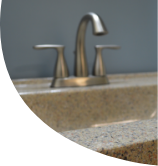6 Questions You Should Ask Your Bathtub Resurfacing Professional
If you’ve never had your bathtub resurfaced you might not know the right questions to ask during the estimate process. Bathtub resurfaces vary in price across the DMV area so it is important to have a few questions in mind to ask your resurfacing professional. Asking all the right questions during the beginning of the process will eliminate any confusion at the start of the project.
Is removal of the existing caulking & a re-caulk around the bathtub included with the service?
In some cases the answer is no so it is good to know exactly what you’re getting with each service. Some refinishers will ask you the remove the old caulking from around the tub before they arrive for the resurface. And in that case you would also be responsible for re-caulking around the bathtub once it is done curing. Other places will remove the existing caulking and replace it for an additional fee. That may be worth pursuing since a professional re-caulk will give the bathtub a completed look. But if you don’t want to have to pay a fee for what you feel should be included there there are companies that will include a re-caulk with their bathtub resurfaces.
Is repair to minor damage included with the bathtub resurface?
Most companies will define “minor damage” differently. In some cases it could mean something as little cosmetic rust, scratches in the bottom of the tub, or a dime-sized chip on the lip of the tub. Make sure you understand the company that you’ve hired’s policy on repairing minor damage. In most cases the resurfacing company will ask you to send in some photos of your bathtub to their estimate department. This is the best time to show them any damage on your tub. The most accurate estimate will help prevent frustration and unforeseen repair fees the day of the service.
Do they chemically strip the old finish?
If the bathtub has been previously resurfaced then chances are the word “stripping” was brought up. Stripping is necessary because it removes all of the old coating from a previous resurface so the new coating can bond to the bathtub. This will ensure any warranty the refinishing company is promising because it is impossible to warranty your own surface on top of someone else’s. There will more often than not be an additional fee to strip that old finish because it adds about an hour and a half more to the project. Some homeowners can’t tell if their tub has been resurfaced before, here are a few tips on how to tell. Because it is common for stripping agents to be dangerous to your health ask your refinisher if their products contain methylene chloride or isocyanates.
How long will the job take?
The scope of work with undoubtably effect the length of the project. A basic tub resurface with no bells and whistles will take about three hours on average. Where as, stripping the old finish as well as major repairs will add a few hours to a project and a tile floor resurface will take as long as two days. Be sure to ask your refinishing professional how long your specific project will take.
How long before I can use the bathtub?
A cure time is the length of time necessary for the new coating to set and harden properly. Not letting a bathtub cure adequately could result in premature coating failure. Cure times depend on the materials and coatings that each company uses. It is important not ask how long you must wait before exposing your bathtub to moisture. The average cure time for most resurfacing materials is 12-24 hrs.
How many layers of material are they using?
Not all companies preform the resurfacing the same way so ask how many layers of material your refinishing professional is using. Using too little layers can cause the new coating to fade in areas creating vulnerable spots where the coating could peel. On the other hand, using too many layers can cause the coating to not bond to the surface also causing the tub to peel. Your refinishing professional should know how many layers and the types of materials they are using.


